Buy Now, Pay Later
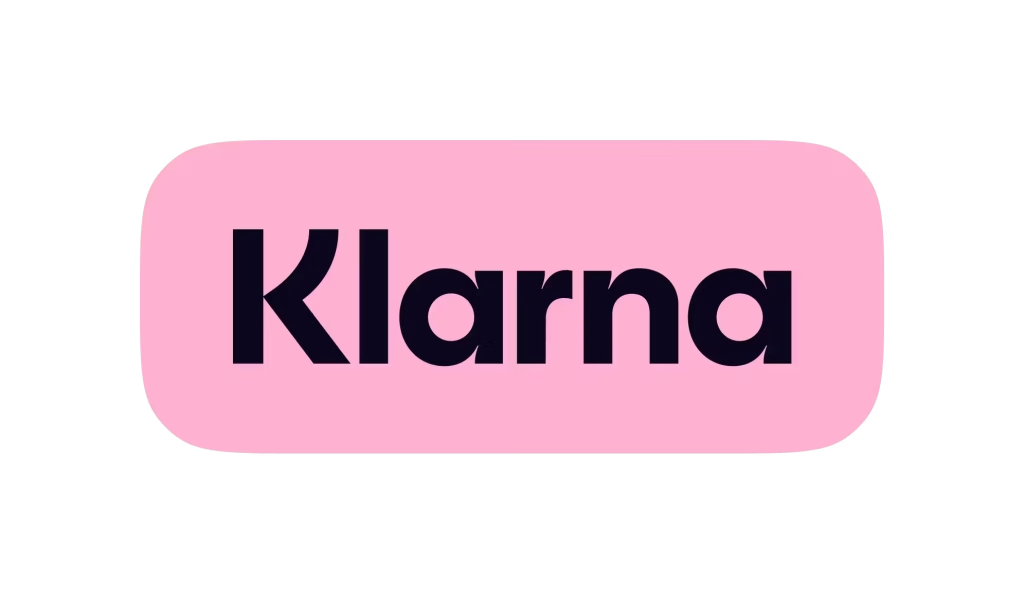
Free Surfboard Advice
Customer Service 9am - 5pm (UK)
Trusted by Pyzel

If you’re new to the world of surfing, you’ll no doubt be pumped to hit the waves and feel that rush which makes surfing a sport loved by so many. We’ve created the ultimate beginner surfboard guide to help guide you finding the perfect surfboard.
Choosing a surfboard suitable for beginners is a big decision for every newbie, but the choice can be overwhelming for groms who don’t yet know their Malibus from their twin fins.
Picking the wrong first surfboard is one of the most common mistakes beginner surfers make, so read on as we explore which surfboard is best for beginners and discover which type of board will work best for you and your local break…
As with starting any new sport, mastering the art of paddling, balancing, and catching waves can be a steep learning curve which can cause frustration for new surfers. When choosing your first surfboard, you’ll want to choose a board which is buoyant, stable and makes catching small waves easy. Choosing a surfboard for beginners will ensure that you start out with the correct board type for your surfing level, help to eliminate common learner mistakes and give you the confidence to progress your skills.
Surfboards come in many shapes, sizes and designs. It’s generally considered that soft-tops are the ideal choice for absolute beginners to start their surfing journey. These boards have a larger surface area than other surfboards which makes them the ideal choice for beginners looking to perfect their balance. They also have greater stability which offers better handling for gliding on small waves, while the soft surface minimises the risk of injuries, making the learning process safer and more enjoyable.
Any board over 8 feet long is typically called a longboard. Many new surfers will have learnt to ride a longboard in their surfing lessons and so they will be familiar with the feel and shape of this perfect beginner surfboard.
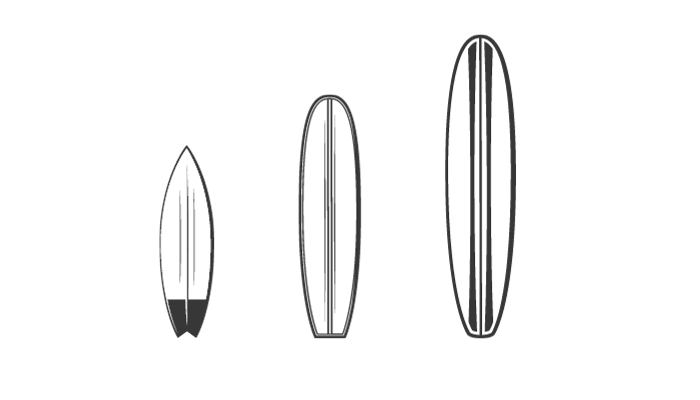
Longboards are also more buoyant which makes paddling easier – this is important for beginner surfers looking to build their confidence as it helps them to catch waves more readily. Longboards are easier to handle in the water, making the learning process less intimidating and more enjoyable, giving beginner surfers the confidence to find their own unique style out on the waves.
When choosing a beginner’s surfboard it’s important not to choose a board that is too big as this can make handling difficult. Equally, you don’t want to buy one that is too small as this will make it trickier to catch those elusive waves!
Choosing a beginner surfboard can be a minefield, but if you follow a few simple guidelines you will be able to learn to surf more easily, and have way more fun. Which is surely what it’s all about!
So which is the best size surfboard for beginners? Our simple surfboard size chart will help you decide…
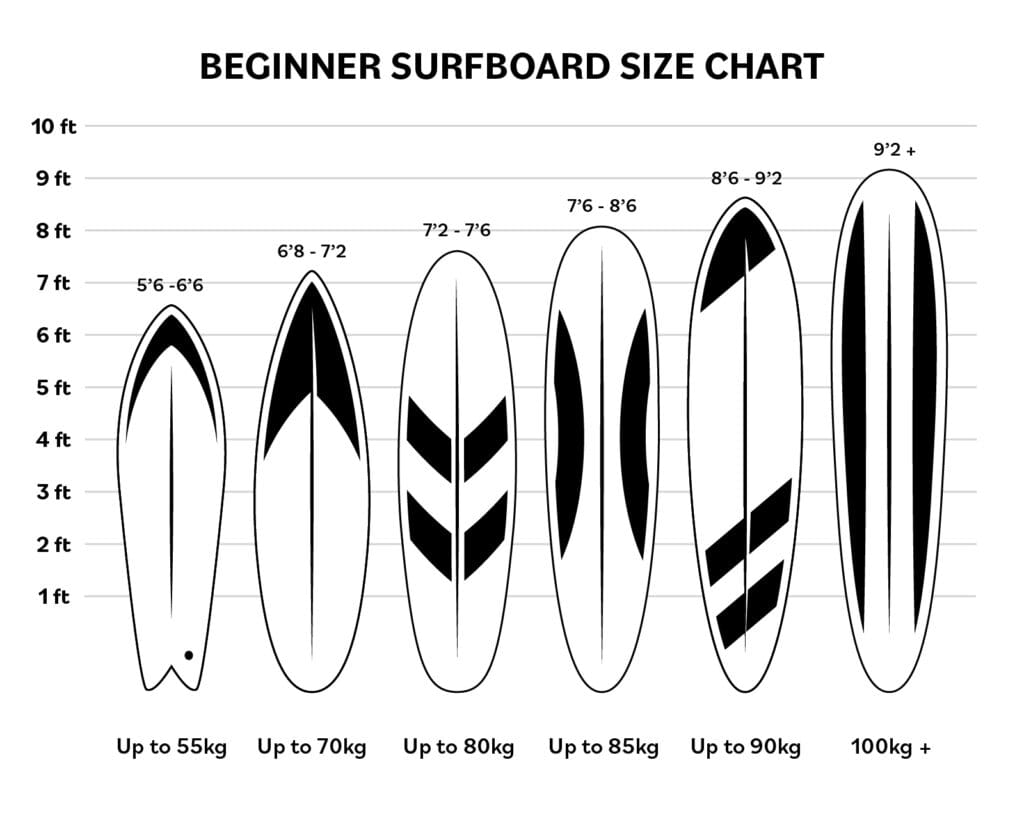
Please note that these are general guidelines based on a surfer’s weight and ability. Each surfer will progress at an individual pace, and it’s also important to remember that as a surfer progresses in skill and confidence, weight will become less of an issue. If you or your child are between sizes on this size chart, we recommend opting for the larger size.
It can take a long time to learn the basics of surfing, so getting a board that lasts will be important when choosing your first surfboard. For any beginner surfer, the most important thing for you will be getting to your feet and catching that wave.
As mentioned above, soft top surfboards are often the most beginner-friendly because they are more forgiving than traditional fibreglass surfboards and easier to stand up on. The soft foam construction of a soft-top/foamie surfboard provides more stability and buoyancy than a hard-top board which makes it easier to learn how to stand up and ride the wave.
Hard top boards are easier to ding or break than soft-tops, meaning that beginners might damage their new board as they will likely spend the majority of the early days falling off! Hardboards are also harder to paddle, so an inexperienced surfer might find it hard work to paddle out and lose enthusiasm more easily than if they were using a soft-top surfboard.
There are five primary types of surfboard shapes, each with its own attributes. There are also a few nicknames for board sizes which may make the defining which surfboard shape is best for beginners an even more confusing task! We outline the main surfboard shapes below to help you understand the key differences-
As mentioned above, the longboard is a surfboard which is longer than 8ft. The nose of a longboard is usually more rounded than its short counterparts and they typically have one single fin. Longboards (also called ‘Mals’ or ‘Malibus’ from the area where they were first seen) are great for beginners due to them being more buoyant and easier to handle than a shortboard.
As the name suggests, a mini mal is a smaller version of the malibu longboard . A mini Mal has similar characteristics and shape as a longboard but is slightly shorter with adult sizes ranging between 7’ 6” and 8’ 6”. They retain the wide, rounded nose but are more compact, offering a balance between stability and manoeuvrability. Mini-Mals are great for those who find longboards too cumbersome but still need the extra stability. If you are looking for a surfboard to take out in any condition, something to teach the kids on and a board which is a good all-rounder, then this is a great option for your beginner surfboard.
Often recommended for absolute beginners, foamie surfboards are soft, extremely buoyant, and reduce the risk of injury during falls. They come in various sizes and are perfect for learning basic surfing skills.he top layer of a foamboard is made of soft foam, which provides a gentle and forgiving surface. This feature is crucial for beginners who are more prone to falls and knocks while learning.
Foamies are an excellent starting point for anyone new to surfing. Their user-friendly design encourages a positive and safe learning environment, allowing beginners to develop their skills and enjoy their time in the waves.
Choosing the right volume and size for your beginner surfboard is crucial for a successful and enjoyable first step into the world of surfing. It’s a careful balancing act to get the right board for you and your size/ability, but it’s important to know that the volume and size of the surfboard will directly impact your stability, paddling ability, and overall performance in the water.
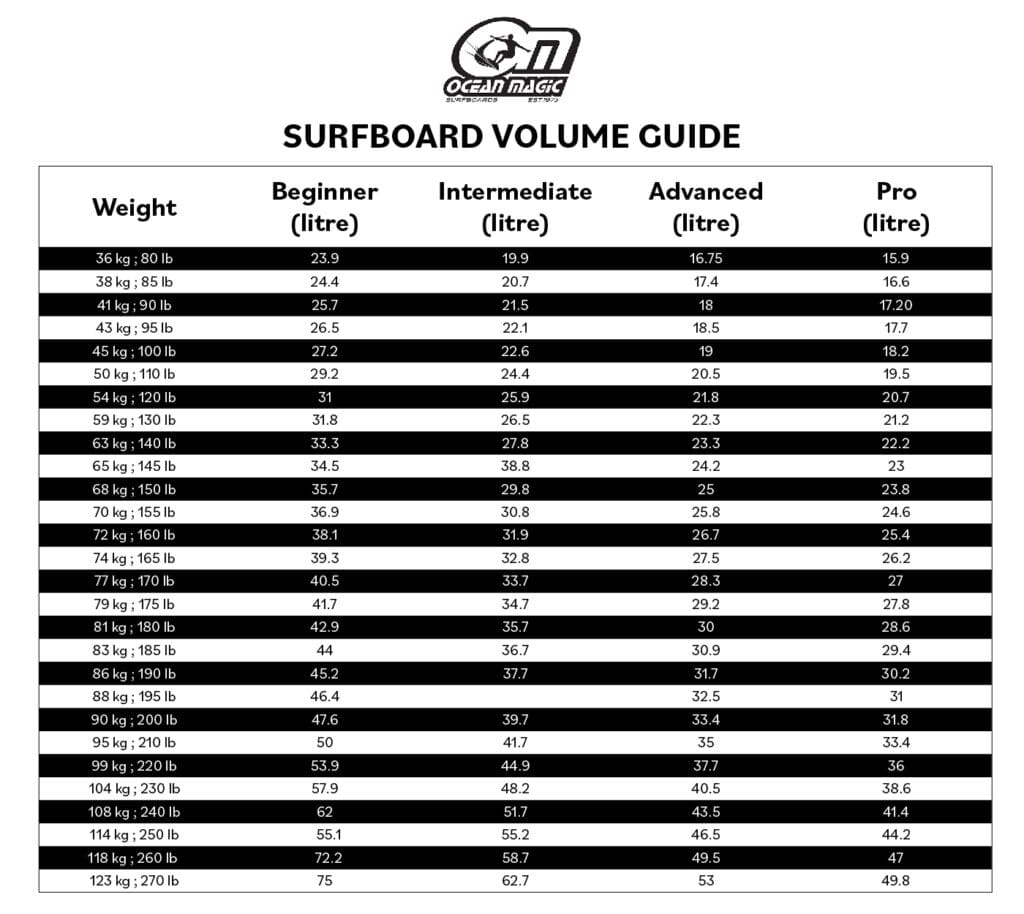
The volume of a surfboard means the amount of space inside the board and it is typically measured in litres. Higher volume provides better stability and buoyancy, making it easier for beginners to paddle, catch waves, and stand up.
As a beginner, we recommend that you aim for a board with higher volume. A good rule of thumb is to select a board with a volume that is at least 2 to 2.5 times your body weight in kilograms. This ensures sufficient buoyancy for stability when on the water.
The size of the surfboard includes its length, width, and thickness. Longer boards provide more stability, while shorter boards are more manoeuvrable. Width and thickness also contribute to stability and paddling ease.
Beginners generally benefit from longer and wider boards. A length between 8 to 10 feet is suitable for most beginners. Wider boards (around 22 to 24 inches) offer more stability. The thickness of the board should be enough to provide buoyancy but not too thick to hinder manoeuvrability.
The design of the tail and nose of a surfboard plays a significant role in how the board performs in the water. For beginners, understanding these designs can be key to selecting a board that supports their learning curve. The tail and nose design of a surfboard greatly influences its stability and agility. Beginners typically benefit from wider designs, which offer a more stable and forgiving platform for learning basic skills. As your abilities develop, experimenting with narrower designs can enhance your agility and open up new possibilities in your surfing experience.
The fin setup on a surfboard significantly influences its handling, stability, and overall performance in the water. For beginners, it’s essential to start with a fin configuration that is conducive to learning and provides the necessary stability. Two popular choices for beginners are the single fin setup and the basic thruster setup.

A single large fin offers simplicity and stability, ideal for those just starting out. The basic thruster setup provides a balance of stability and manoeuvrability, suitable for beginners who are looking to progress more quickly. The choice ultimately depends on your individual preferences, goals, and the conditions in which you’ll be surfing. Make sure to check whether your surfboard is set up for Futures Fins or FCS Fins as these have different box plug shapes!
Starting out and progressing your surfing life on a foamie is a good decision for several reasons. Not only do foamies hold their value so they are easy to sell on once you’re finished, but they are also extremely well-constructed and skilfully-designed these days (a far cry from the foamies of the past!).
The overall volume of a foam board can have a huge impact on your surfing success – we advise considering a high-volume foamie as a brilliant option for beginner surfers looking for some fun. The higher the volume the more “float” the board will have, and the more fun you will have in the sea. Remember that the perfect foamie for your pal might not be the perfect foamie for you. It’s important to speak to a surfboard expert and work out which will be the best foamie for you.
So you’ve loved learning the ropes and perfecting your new surf skills on a foamie, but what comes next? Which surfboard is best for when you feel ready to transition to your next board?
In our experience, most people suit a round-nose shortboard or Mini Mal for their next board after a foamie. With a size range of 7’2” to 8’ 6”, Mini Mals are the perfect size for easy paddling and simple turns. Any bigger and paddling will become hard work, any smaller then you will find manoeuvrability will become an issue.
Think about your progression in the sport – a board with a little extra volume may serve you well as you advance beyond the beginner stage and mean that you can hold on to it a little longer before investing in your next board.
It’s not just the size, shape and volume of the board which determines the best beginner surfboard for you, it’s also vital that you take into account the conditions of your local break.
Make sure that you consider the type of waves you’ll be surfing in and the conditions of your local/most-frequented beach.. Be sure to assess your local wave before deciding on that all-important beginner surfboard and think about these vital points:
By choosing a board that aligns with your skill level and local break, you’ll increase your chances of having a positive and enjoyable surfing experience from the start.
Selecting the right beginner surfboard involves the consideration of many factors, including board type, wave conditions, size, shape, construction material, fins, board volume and personal ability. We highly advise getting local advice from a trusted, experienced surfboard retailer so that you can make the best decision about a beginner board for you.
Here at Ocean Magic we are an approachable and friendly surfer family passionate about surfing. We want to get to know you to help you get the perfect beginner surfboard for your first step into the world of surfing, so get in touch today and let’s get started together!
© 2024 Ocean Magic – The Factory. All rights reserved. Company Number: 04664716. VAT Registered 807 8508 12
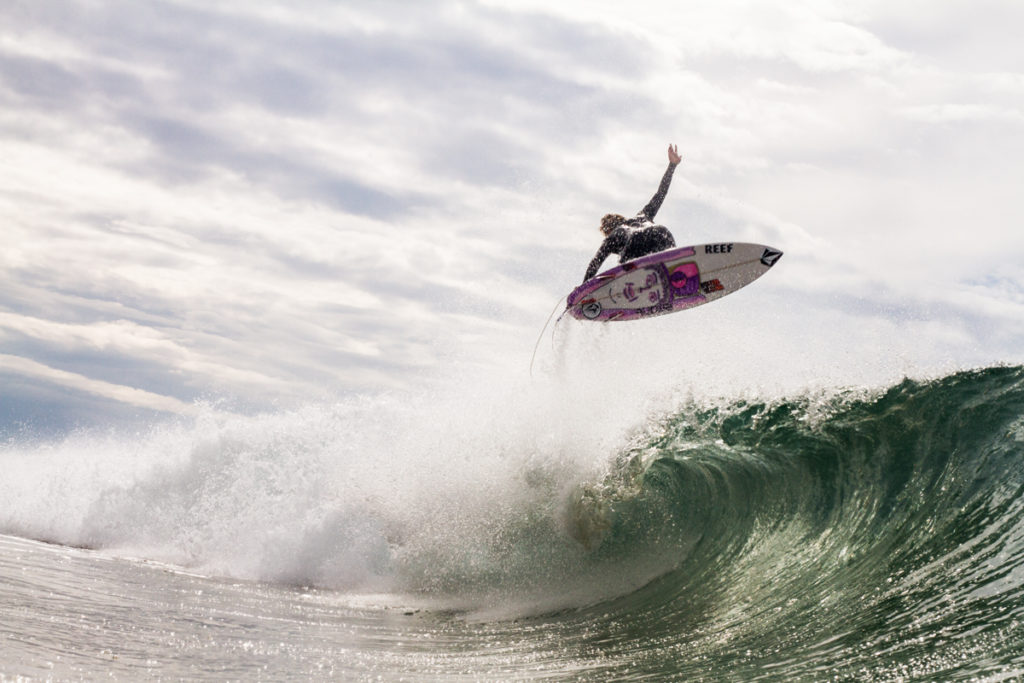
Get 10% off your first order!
Join the Lineup!